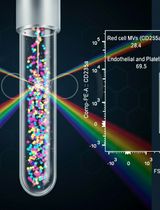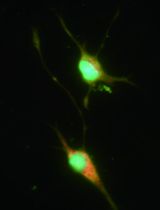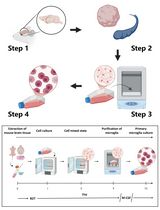- EN - English
- CN - 中文
Flow Cytometry of CD14, VDR, Cyp27 and Cyp24 and TLR4 in U937 Cells
流式细胞术检测U937细胞CD14、VDR、Cyp27、Cyp24和TLR4
(*contributed equally to this work) 发布: 2020年08月05日第10卷第15期 DOI: 10.21769/BioProtoc.3695 浏览次数: 4315
评审: Xiaoyi ZhengYing ShiAnonymous reviewer(s)

相关实验方案

外周血中细胞外囊泡的分离与分析方法:红细胞、内皮细胞及血小板来源的细胞外囊泡
Bhawani Yasassri Alvitigala [...] Lallindra Viranjan Gooneratne
2025年11月05日 1328 阅读
Abstract
Chronic Kidney Disease (CKD) patients present a micro inflammation state due to failure renal function. The calcitriol has been described as an anti-inflammatory factor that might modulates the inflammatory response in CKD patients. However, these patients have deficiency of Calcitriol due to failure renal function. But, synthesis of this vitamin has been reported in extra renal production, as in monocytes. In this context, it has been reported that the supplementation with 25 vitamin D (calcidiol or inactive form of vitamin D) induces monocytes to downregulate inflammation, due to the intracellular 1α-hidroxilase that converts calcidiol to calcitriol in these cells. Besides some reports used RT-qPCR, Western Blot or immunofluorescence techniques to investigate the expression of inflammatory and vitamin D machinery biomarkers in several disease, in the present study we used flow cytometry technique to evaluate the effect of 25 vitamin D on CD14, Toll-like receptor 4 (TLR4), vitamin D receptor (VDR), 1-α hydroxylase (CYP27), 24 hydroxylase (CYP24) in monocytes lineage (U937). The U937 culture was incubated with healthy or CKD serum and treatment with/without 25-vitamin D (50 ng/ml for 24 h) to evaluate CD14, TRL4, VDR, CYP27 and CYP24 expression. This protocol showed the advantage to investigate the effect of treatment with 25 vitamin D on the intracellular and cell membrane biomarkers expression quickly and simultaneously. In addition, this technique is not laborious, but easy to perform and to interpret compared to RT-qPCR, western blot or immunofluorescence.
Keywords: 25 vitamin D (25羟维生素D)Background
Chronic Kidney Disease (CKD) is characterized by the failure filtration rate resulting in serum accumulation of toxic substances, called uremic toxins (Vanholder et al., 2003). It has been shown that uremic toxins induce an inflammatory response in patients with CKD (Rossi et al., 2014; Borges et al., 20 16; Kaminski et al., 2017). Several studies have been reported a relationship between uremic toxins as indoxyl sulfate, p-cresyl sulfate, and indole-3-acetic acid with inflammation (Rossi et al., 2014; Lau et al., 2018; Onal et al., 2019). These toxins signalize NF-ĸB, oxidative stress, upregulated cytokines, intercellular adhesion molecule-1 (ICAM-1) (Bolati et al., 2013; Shimizu et al., 2013; Stockler-Pinto et al., 2018), and induce endothelial injury, contributing to endothelial dysfunction (Carmona et al., 2017). In addition, with the loss of renal function, there is no synthesis of the 1α-hidroxilase enzyme that converts calcidiol (25(OH)D/inactive form of vitamin D) to calcitriol (1,25(OH)2D–active form of vitamin D). The uremic toxins and deficiency of calcitriol have been described to contribute to inflammation in this population (Franca Gois et al., 2018). The calcitriol has been described as anti-inflammatory (Tsoukas et al., 1984; Mathieu and Adorini, 2002). However, in the last 20 years, it has been reported that there is an extra renal production of this vitamin, mainly in monocytes (Stumpf et al., 1979; Schwartz et al., 1998; Cross et al., 2001; Holick, 2007, Gombart et al., 2007). The monocytes have the enzyme 1α-hydroxylase (CYP27) that convert calcidiol (25(OH)D–inactive form of vitamin D) to calcitriol (1,25(OH)2D) and 24 hidroxilase (CYP24) that regulate 1,25(OH)2D over production. The extrarenal synthesis of calcitriol might be linked to autocrine and paracrine biologic regulatory mechanisms, mainly in cells of the immunologic system (Aranow, 2011; Holick, 2012). Besides, the monocytes have TLR-4 and TLR-2 receptors that recognize antigens and activation of these receptors increased expression of VDR (vitamin D receptor) and CYP27, both regulate the conversion of inactive to active form of vitamin D (Kreutz et al., 1993).
As uremic toxins and hypovitaminosis D are important in inflammatory state in CKD environment, the aim of our study was to evaluate in vitro the effect of 25-vitamin D on TLR4, VDR, CYP27 and CYP24 in human monocyte lineage (U937). For this purpose, we evaluated TLR4 and the vitamin D intracellular mechanisms by flow cytometry.
In fact, in our previous study, we have already used this protocol and observed that 25(OH)D improved CYP27 and decreased IL-6, IFN-γ, TLR7 and TLR9 intracellular expression in lymphocytes from dialysis patients (Carvalho et al., 2017).
The VDR, CYP27 and CYP24 can be detected by other techniques such as RT-qPCR, Western-blot and immunohistochemistry as reported by Zou et al. (2019). In this study, authors investigated the effect of Shenyuan granules on the Klotho/FGFR23/Egr1 signaling pathway and calcium-phosphorus metabolism in diabetic nephropathy. Similarly, Chang et al. (Chang and Kim, 2019; Chang, 2019) investigated the effect of vitamin D on muscle cell (C2C12) proliferation and differentiation via VDR, CYP24 and CYP27 by RT-qPCR.
Although RT-qPCR, Western Blot and Immunofluorescence are techniques with high sensitivity and specificity to assess the expression of the TLR4, VDR, CYP27 and CYP24 gene, these are laborious techniques, requiring several stages for their performance (which can contribute to the failure of the techniques), require a large number of cells, high cost compared to the protocol described in the present study using flow cytometry, which is less laborious and easy to perform. Besides CKD patients, this protocol can also be applied in other researches and clinical areas such as oncology, auto immune disease, immune response, since vitamin D may modulate several cell types as lymphocytes that expression VDR, CYP27 and CYP24.
Materials and Reagents
- 25 cm2 cell culture flask (Sigma-Aldrich, catalog number: SIAL0168 ), storage: room temperature
- Coverslip: 18 x 18 mm Thickness 0.13-0.17 mm (Amscope, catalog number: CS-S18-100 , storage: room temperature
- U937 human monocytic lineage cell (ATCC, catalog number: TIB-202 ), storage: Liquid Nitrogen
- APC-VDR secondary antibody, clone mouse (Invitrogem, catalog number: Z25151 ), storage: 8 °C
- CD14-FITC anti-human monoclonal antibody, clone 61D3 (eBioscience, catalog number: 11014942 ), storage: 8 °C
- RPMI 1640 culture medium, pH 7.4 (Sigma-Aldrich, catalog number: R4130 ), storage: 8 °C
- Pen Strep Solution 100 ml (Penicillin Streptomycin) (Gibco by Life Technologies, catalog number: 15140-122 ), storage: -20 °C
- PMA (Phorbol 12-myristate 13-acetate) (Sigma-Aldrich, catalog number: P1585 ), storage: -20 °C
- PBS (Phosphate buffered saline pH 7.4) (Sigma-Aldrich, catalog number: P3744-1 PAK ), storage: room temperature
- Trypsin EDTA solution (Sigma-Aldrich, catalog number: T4049 ), storage: -20 °C
- FBS (Fetal Bovine Serum) (Sigma-Aldrich, catalog number: 12103C ), storage: -20 °C
- Trypan Blue solution (Sigma-Aldrich, catalog number: T8154 ), storage: room temperature
- 25(OH)D (25-Hydroxyvitamin D3 solution 50 µg/ml in ethanol) (Sigma-Aldrich, catalog number: 739642 ), storage: -20 °C
- TLR4-PE anti-human monoclonal antibody, clone HTA125 (eBioscience, catalog number: 12991742 ), storage: 8 °C
- VDR anti-human monoclonal antibody, clone H1512 (Santa Cruz, catalog number: SC13133 ), storage: 8 °C
- CYP27B1 anti-human monoclonal antibody, clone K2911 (Santa Cruz, catalog number: SC49642 ), storage: 8 °C
- Alexa Fluor 647-CYP27B1 secondary antibody, clone goat (Invitrogem, catalog number: Z25608 ), storage: 8 °C
- CYP24 anti-human monoclonal antibody, clone D0811 (Santa Cruz, catalog number: SC66851 ), storage: 8 °C
- Alexa Fluor 488-CYP24 secondary antibody, clone rabbit (Invitrogem, catalog number: Z5302 ), storage: 8 °C
- Fixation/permeabilization buffer–Cytofix/Cytoperm (1x) (BD Pharmingen, catalog number: 554722 ), storage: 8 °C
- Wash buffer containing saponin–Perm/Wash buffer (BD Pharmingen, catalog number: 554723 ), storage: 8 °C
- DMSO (dimetilsulfoxide) (Synth, catalog number: 01D1011.01.BJ ), storage: room temperature
- Sodium azide (Merckmillipore, catalog number: 247-852-1 ), storage: room temperature
- Anticoagulants EDTA (Disodium ethylenediaminetetraacetate dihydrate) (Sigma-Aldrich, catalog number: ED2SS-100g ), storage: room temperature
- Azide sodium (Sigma-Aldrich, catalog number: S2002-100g ), storage: room temperature
- PMA (PhorboI12-Myristate 13-Acetate) (see Recipes)
- 500 ng/ml 25(OH)D (see Recipes)
- 1% Azide PBS solution (see Recipes)
Equipment
- -80 °C freezer
- Hemocytometer/Neubauer chamber (Microyntech, catalog number: MT-BCC-BL , storage: room temperature)
- Flow Citometer: FacsCanto I four parameters (BD Biosciences, San Diego, USA)
- CO2 incubator 4110 (Thermo Fisher Scientific, USA)
- Centrifuge 5804 R (Eppendorf, Germany)
Software
- BD FACSDivaTM (BD Biosciences, San Diego, USA; www.bdbiosciences.com)
- SPSS version 22 statistics software (SPSS, Chicago, USA)
Procedure
文章信息
版权信息
© 2020 The Authors; exclusive licensee Bio-protocol LLC.
如何引用
Rebello, J. F., de Oliveira Brito, R. B., Grabulosa, C. C., Moyses, R. M. A., Elias, R. M. and Dalboni, M. A. (2020). Flow Cytometry of CD14, VDR, Cyp27 and Cyp24 and TLR4 in U937 Cells. Bio-protocol 10(15): e3695. DOI: 10.21769/BioProtoc.3695.
分类
免疫学 > 免疫机理 > 体外模型
细胞生物学 > 基于细胞的分析方法 > 流式细胞术
细胞生物学 > 细胞分离和培养 > 细胞分离
您对这篇实验方法有问题吗?
在此处发布您的问题,我们将邀请本文作者来回答。同时,我们会将您的问题发布到Bio-protocol Exchange,以便寻求社区成员的帮助。
Share
Bluesky
X
Copy link











